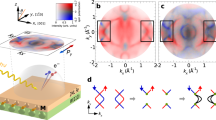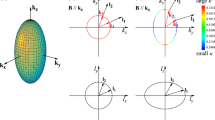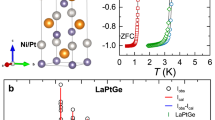Abstract
The Fermi surface plays an important role in controlling the electronic, transport and thermodynamic properties of materials. As the Fermi surface consists of closed contours in the momentum space for well-defined energy bands, disconnected sections known as Fermi arcs can be signatures of unusual electronic states, such as a pseudogap1. Another way to obtain Fermi arcs is to break either the time-reversal symmetry2 or the inversion symmetry3 of a three-dimensional Dirac semimetal, which results in formation of pairs of Weyl nodes that have opposite chirality4, and their projections are connected by Fermi arcs at the bulk boundary3,5,6,7,8,9,10,11,12. Here, we present experimental evidence that pairs of hole- and electron-like Fermi arcs emerge below the Neel temperature (TN) in the antiferromagnetic state of cubic NdBi due to a new magnetic splitting effect. The observed magnetic splitting is unusual, as it creates bands of opposing curvature, which change with temperature and follow the antiferromagnetic order parameter. This is different from previous theoretically considered13,14 and experimentally reported cases15,16 of magnetic splitting, such as traditional Zeeman and Rashba, in which the curvature of the bands is preserved. Therefore, our findings demonstrate a type of magnetic band splitting in the presence of a long-range antiferromagnetic order that is not readily explained by existing theoretical ideas.
This is a preview of subscription content, access via your institution
Access options
Access Nature and 54 other Nature Portfolio journals
Get Nature+, our best-value online-access subscription
$29.99 / 30 days
cancel any time
Subscribe to this journal
Receive 51 print issues and online access
$199.00 per year
only $3.90 per issue
Buy this article
- Purchase on Springer Link
- Instant access to full article PDF
Prices may be subject to local taxes which are calculated during checkout




Similar content being viewed by others
Data availability
The raw data for this work are available at the Materials Data Facility: https://doi.org/10.18126/P9B8-E7MS.
Change history
21 April 2022
A Correction to this paper has been published: https://doi.org/10.1038/s41586-022-04705-1
References
Norman, M. R. et al. Destruction of the Fermi surface in underdoped high-Tc superconductors. Nature 392, 157–160 (1998).
Wang, Z. et al. Time-reversal-breaking Weyl fermions in magnetic Heusler alloys. Phys. Rev. Lett. 117, 236401 (2016).
Xu, S. Y. et al. Discovery of a Weyl fermion semimetal and topological Fermi arcs. Science 349, 613–617 (2015).
Armitage, N. P., Mele, E. J. & Vishwanath, A. Weyl and Dirac semimetals in three dimensional solids. Rev. Mod. Phys. 90, 015001 (2018).
Huang, L. et al. Spectroscopic evidence for a type II Weyl semimetallic state in MoTe2. Nat. Mater. 15, 1155–1160 (2016).
Tamai, A. et al. Fermi arcs and their topological character in the candidate type-II Weyl semimetal MoTe2. Phys. Rev. X 6, 031021 (2016).
Deng, K. et al. Experimental observation of topological Fermi arcs in type-II Weyl semimetal MoTe2. Nat. Phys. 12, 1105–1110 (2016).
Wan, X., Turner, A. M., Vishwanath, A. & Savrasov, S. Y. Topological semimetal and Fermi-arc surface states in the electronic structure of pyrochlore iridates. Phys. Rev. B 83, 205101 (2011).
Hirschberger, M. et al. The chiral anomaly and thermopower of Weyl fermions in the half-Heusler GdPtBi. Nat. Mater. 15, 1161–1165 (2016).
Morali, N. et al. Fermi-arc diversity on surface terminations of the magnetic Weyl semimetal Co3Sn2S2. Science 365, 1286–1291 (2019).
Xu, Q. et al. Topological surface Fermi arcs in the magnetic Weyl semimetal Co3Sn2S2. Phys. Rev. B 97, 235416 (2018).
Niels B. M. et al. Weyl fermions, Fermi arcs, and minority-spin carriers in ferromagnetic CoS2. Sci. Adv. https://www.science.org/doi/pdf/10.1126/sciadv.abd5000 (2020).
Smejkal, L., Gonzalez-Hernandez, R., Jungwirth, T. & Sinova, J. Crystal time-reversal symmetry breaking and spontaneous Hall effect in collinear antiferromagnets. Sci. Adv. 6, eaaz8809 (2020).
Ahn, K. H., Hariki, A., Lee, K. W. & Kuněs, J. Antiferromagnetism in RuO2 as d-wave Pomeranchuk instability. Phys. Rev. B 99, 184432 (2019).
Schulz, S. et al. Classical and cubic rashba effect in the presence of in-plane 4f magnetism at the iridium silicide surface of the antiferromagnet GdIr2Si2. Phys. Rev. B 103, 035123 (2021).
Usachov, D. Y. et al. Cubic Rashba effect in the surface spin structure of rare-earth ternary materials. Phys. Rev. Lett. 124, 237202 (2020).
Kumigashira, H. et al. High-resolution angle-resolved photoemission spectroscopy of CeBi. Phys. Rev. B 54, 9341–9345 (1996).
Canfield, P. C. & Fisk, Z. Growth of single crystals from metallic fluxes. Philos. Mag. B 65, 1117–1123 (1992).
Canfield, P. C. & Fisher, I. R. High-temperature solution growth of intermetallic single crystals and quasicrystals. J. Cryst. Growth 225, 155–161 (2001).
Wu, Y. et al. Electronic structure of RSb (R=Y, Ce, Gd, Dy, Ho, Tm, Lu) studied by angle-resolved photoemission spectroscopy. Phys. Rev. B 96, 035134 (2017).
Kuroda, K. et al. Experimental determination of the topological phase diagram in cerium monopnictides. Phys. Rev. Lett. 120, 086402 (2018).
Duan, X. et al. Tunable electronic structure and topological properties of LnPn (Ln=Ce, Pr, Sm, Gd, Yb; Pn=Sb, Bi). Commun. Phys. 1, 71 (2018).
Guo, C. et al. Possible Weyl fermions in the magnetic Kondo system CeSb. npj Quant. Mater. 2, 39 (2017).
Huang, Z. et al. Prediction of spin polarized Fermi arcs in quasiparticle interference in CeBi. Phys. Rev. B 102, 235167 (2020).
Oinuma, H. et al. Unusual change in the Dirac-cone energy band upon a two-step magnetic transition in CeBi. Phys. Rev. B 100, 125122 (2019).
Kuroda, K. et al. Devil’s staircase transition of the electronic structures in CeSb. Nat. Commun. 11, 2888 (2020).
C. E. Matt, et al. Spin-polarized imaging of strongly interacting fermions in the ferrimagnetic state of Weyl candidate. Preprint at https://arxiv.org/abs/2012.14911 (2020).
Tsuchida, T. & Wallace, W. E. Magnetic characteristics of lanthanide–bismuth compounds. J. Chem. Phys. 43, 2087–2092 (1965).
Nereson, N. & Arnold, G. Magnetic properties of CeBi, NdBi, TbBi, and DyBi. J. Appl. Phys. 42, 1625–1627 (1971).
Schobinger-Papamantellos, P., Fischer, P., Vogt, O. & Kaldis, E. Magnetic ordering of neodymium monopnictides determined by neutron diffraction. J. Phys. C 6, 725–737 (1973).
Venus, D. Magnetic circular dichroism in angular distributions of core-level photoelectrons. Phys. Rev. B 48, 6144–6151 (1993).
Wang, Y. H. et al. Observation of a warped helical spin texture in Bi2Se3 from circular dichroism angle-resolved photoemission spectroscopy. Phys. Rev. Lett. 107, 207602 (2011).
Petrovykh, D. Y. et al. Spin-dependent band structure, Fermi surface, and carrier lifetime of permalloy. Appl. Phys. Lett. 73, 3459–3461 (1998).
Rashba, E. I. & Sheka, V. I. Symmetry of energy bands in crystals of wurtzite type: II. Symmetry of bands including spin-orbit interaction. Fiz. Tverd. Tela – Collected Papers 2, 162–176 (1959). (See also G. Bihlmayer et al. New J. Phys. 17, 050202 (2015)).
Topp, A. et al. Surface floating 2D bands in layered nonsymmorphic semimetals: ZrSiS and related compounds. Phys. Rev. 7, 041073 (2017).
Canfield, P. C., Kong, T., Kaluarachchi, U. S. & Jo, N. H. Use of frit-disc crucibles for routine and exploratory solution growth of single crystalline samples. Philos. Mag. 96, 84–92 (2016).
Canfield, P. C., Kong, T., Kaluarachchi, U. S. & Jo, N. H. Canfield crucible sets. LSP Industrial Ceramics https://lspceramics.com/canfield-crucible-sets-2/ (accessed 18 February 2022).
Canfield, P. C. New materials physics. Rep. Prog. Phys. 83, 016501 (2019).
Fisher, M. E. Relation between the specific heat and susceptibility of an antiferromagnet. Philos. Mag. 7, 1731–1743 (1962).
Fisher, M. E. & Langer, J. S. Resistive anomalies at magnetic critical points. Phys. Rev. Lett. 20, 665–668 (1968).
Jiang, R. et al. Tunable vacuum ultraviolet laser based spectrometer for angle resolved photoemission spectroscopy. Rev. Sci. Instrum. 85, 033902 (2014).
Scholz, M. R. et al. Reversal of the circular dichroism in angle-resolved photoemission from Bi2Te3. Phys. Rev. Lett. 110, 216801 (2013).
M. Zeng, et al. Topological semimetals and topological insulators in rare earth monopnictides. Preprint at https://arxiv.org/abs/1504.03492 (2015).
Wu, Y. et al. Asymmetric mass acquisition in LaBi: topological semimetal candidate. Phys. Rev. B 94, 081108(R) (2016).
Kenta, K. et al. Experimental determination of the topological phase diagram in cerium monopnictides. Phys. Rev. Lett. 120, 086402 (2018).
Peng, L. et al. “Tunable electronic structure and surface states in rare-earth monobismuthides with partially filled f shell,”. Phys. Rev. B 98, 085103 (2018).
Acknowledgements
We thank A. Vishwanath, A. Chubukov and J. Schmalian for useful discussions and comments. ARPES measurements were supported by the US Department of Energy (DOE), Office of Basic Energy Sciences, Division of Materials Science and Engineering. Ames Laboratory is operated for the US Department of Energy by Iowa State University under contract no. DE-AC02-07CH11358. Crystal growth and characterization were supported by the Center for the Advancement of Topological Semimetals (CATS), an Energy Frontier Research Center funded by the US DOE, Office of Basic Energy Sciences. R.-J.S. acknowledges funding from the Marie Sklodowska-Curie programme under EC grant no. 842901 and the Winton programme, as well as Trinity College at the University of Cambridge. J.A. was supported by the Basic Science Research Program through the National Research Foundation of Korea (NRF) funded by the Ministry of Education (grant no. 2020R1A6A3A03037129) and CATS. A.F. and R.L. acknowledge support from SFB1143 ‘Correlated Magnetism’, Würzburg-Dresden Cluster of Excellence on Complexity and Topology in Quantum Matter-ct.qmat. R.L. acknowledges support from National Natural Science Foundation of China (grant no. 11904144). J.S.-B. gratefully acknowledges financial support from the Impuls- und Vernetzungsfonds der Helmholtz-Gemeinschaft under grant no. HRSF-0067.
Author information
Authors and Affiliations
Contributions
B.S., P.C.C. and A.K. conceived and designed the experiment. Y.K. and A.K. performed analysis of ARPES data. J.A. and R.-J.S. provided theoretical analysis and interpretation. B.K., S.L.B. and P.C.C. grew and characterized the samples. L.-L.W. performed DFT calculations. B.S., Y.K., E.O’L., K.L., A.E., A.F., R.L., V.V., O.J.C., J.S.-B. and A.K. performed ARPES measurements and support. The manuscript was drafted by J.A., B.S., R.-J.S., P.C.C. and A.K. All authors discussed and commented on the manuscript.
Corresponding authors
Ethics declarations
Competing interests
The authors declare no competing interests.
Peer review
Peer review information
Nature thanks Hendrik Bentmann and the other, anonymous, reviewer(s) for their contribution to the peer review of this work. Peer reviewer reports are available.
Additional information
Publisher’s note Springer Nature remains neutral with regard to jurisdictional claims in published maps and institutional affiliations.
Extended data figures and tables
Extended Data Fig. 1 Basic sample characterization.
a, Derivatives of resistivity and magnetization (dρ/dT and d(M(T)/H)/dT) plotted as a function of temperature. b, Powder X-ray diffraction pattern for NdBi. Blue vertical lines show the expected Bragg peak positions, agreeing well with the observed pattern. Green asterisks show impurity peaks coming from Bi flux. hkl indices are assigned comparing with the reported structure.
Extended Data Fig. 2 Photon energy-dependent data.
a, Fermi surface maps in the AFM state measured using light with different photon energy are shown in the left column. b, Corresponding dispersions along directions depicted by the horizontal and the vertical line on the map are shown in the central and the right columns, respectively. c, The shape of the dispersion in Γ-X direction obtained by EDC fitting. Bullets and crosses represent results obtained from two different cleaves.
Extended Data Fig. 3 ARPES data from NdBi in AFM and PM states measured using 21.2 eV photons.
a, Data measured along Γ - X direction in the AFM state at T=10 K. b, Data measured along Γ - X direction in the PM state at T=30 K. c, Momentum Distribution Curves (MDC) plotted at EF from data in panels a, b.
Extended Data Fig. 4 Circular dichroism and polarization dependence.
a, Plot of portion of Fermi surface in the area where surface states are present measured using linearly polarized light b, and c, ARPES data along cut marked in panel (a) measured in the AFM and PM state respectively (sum of spectra measured using left and right circular polarization). d, dichroic signal from FS as in panel (a) e, and f, dichroic signal in AFM and PM state along same cuts as in (b) and (c) (difference of spectra measured using left and right circular polarization). g, and h, ARPES data along cut #5 marked Fig. 3c in 45 deg. sample orientation in the AFM and PM state respectively. i, and j, dichroic signal in AFM and PM state along same cuts as in (g) and (h). k, large area Fermi surface map. l, and m, ARPES spectra along cut marked with line #1 in (k) measured using linear horizontal and linear vertical polarized light, respectively. n and o, ARPES spectra along cut marked with line #2 in (k) measured using linear horizontal and linear vertical polarized light, respectively.
Extended Data Fig. 5 Reproducibility and ageing data.
a, Fermi surface maps measured from eight different samples in the AFM state. b, Spectra measured along the direction shown with a dashed line in the plot a#2 at different temperatures. A number of hours represents the time after cleave when a spectrum was measured. c, Two Fermi surface maps and two spectra measured from another sample at different times after cleave: from 6 to 24 hours. The spectra were measured in along direction shown with a dashed line in the map.
Extended Data Fig. 6 Synchrotron data.
a, Fermi surface map measured using 23eV light at T=8K. b, Spectrum measured throw the surface electron-like pocket on another sample one hour after its cleaving. c, The same spectrum measured 5 hours later.
Extended Data Fig. 7 Schematic illustration of various band backfolding scenarios.
a, schematic plot of 2D projected bulk FS based on calculations from Fig. 1c. b, 3D bulk FS and 2D projection when magnetic ordering vector is perpendicular to sample surface. c, same as b, but for magnetic order parallel to the sample surface. Blue arrows point to parts of the surface states that exist outside the areas where bulk electron shadow band overlaps with bulk hole pocket.
Extended Data Fig. 8 Absence of observable signal from bulk shadow bands.
a, FS plot in AFM state. Green dashed line marks MZB for in-plane magnetic ordering vector. b, data along cuts on left and right side, equally distanced from MZB in PM state (top row) and AFM state (bottom row). c, MDC from cuts in panel b at EF. Dashed lines mark strong shoulders from bulk electron pocket on right side of MZB. Insets show magnified data at momenta where bulk electron shoulders due to shadow bands are expected. d, MDC from cuts in panel b at E=-40 meV. Dashed lines mark strong shoulders from bulk electron pocket on right side of MZB. Insets show magnified data at momenta where bulk electron shoulders due to shadow bands are expected.
Extended Data Fig. 9 simulation of shadow intensity for in-plane backfolding.
a, Data along the cut on the left side of MZB (marked in Extended Data Fig. 8a). b, Data along the cut on the right side of MZB (marked in Extended Data Fig. 8a). c, Sum of data in panel a and 10 % of intensity from panel b simulating 10 % backfolding in AFM state. d, Actual data along the same cut as in panel a in AFM state.
Extended Data Fig. 10 DFT calculations.
a, spectral functions of NdBi (001) surface in paramagnetic (non-magnetic - NM) configuration. b, spectral functions of NdBi (001) surface for A-type antiferromagnetic (AFMA) configuration stacked along (001) with moment also along (001). c, spectral functions of NdBi (001) surface for intralayer checkerboard AFM (AFMC) with moment along (001). d-f, the 2D Fermi surfaces at the constant energy of EF for the three magnetic configurations NM, AFMA and AFMC, respectively. g-i, the 2D Fermi surfaces at the constant energy of EF–0.15 eV for the three magnetic configurations NM, AFMA and AFMC, respectively. The surface Brillouin zone of AFMC is rotated by 45 degree and folded from that of NM and AFMA.
Supplementary information
Rights and permissions
About this article
Cite this article
Schrunk, B., Kushnirenko, Y., Kuthanazhi, B. et al. Emergence of Fermi arcs due to magnetic splitting in an antiferromagnet. Nature 603, 610–615 (2022). https://doi.org/10.1038/s41586-022-04412-x
Received:
Accepted:
Published:
Issue Date:
DOI: https://doi.org/10.1038/s41586-022-04412-x
This article is cited by
-
Hidden non-collinear spin-order induced topological surface states
Nature Communications (2024)
-
Observation of plaid-like spin splitting in a noncoplanar antiferromagnet
Nature (2024)
-
Unconventional surface state pairs in a high-symmetry lattice with anti-ferromagnetic band-folding
Communications Physics (2023)
-
Antiferromagnetic topological insulator with selectively gapped Dirac cones
Nature Communications (2023)
-
Origin of the exotic electronic states in antiferromagnetic NdSb
npj Quantum Materials (2023)
Comments
By submitting a comment you agree to abide by our Terms and Community Guidelines. If you find something abusive or that does not comply with our terms or guidelines please flag it as inappropriate.



